
Original Link: https://www.anandtech.com/show/1545
NVIDIA's GeForce 6600GT AGP: The Little Bridge that Could
by Anand Lal Shimpi on November 16, 2004 12:15 PM EST- Posted in
- GPUs
Intel did a very good job of drumming up support for PCI Express over the past two years. Look around and note that all of the motherboard manufacturers have quite a few PCI Express based motherboard designs. Then look at the latest GPU launches from ATI and NVIDIA, all of the exciting products appear to be launched first (or primarily) as PCI Express designs. While everyone industry-wide has done a great job of supporting PCI Express, there's one little problem - no one seems to be interested in buying PCI Express solutions just yet.
The OEM markets have no problems shipping PCI Express motherboards and graphics cards in their systems, after all they want to sell the idea of buying an entirely new PC in order to get access to brand new technologies like PCI Express. However in the channel and upgrade markets, PCI Express solutions aren't selling well at all. Most enthusiast users appear to be sticking with their AGP platforms and while they would consider a GPU upgrade, they are not willing to upgrade their motherboard (and sometimes CPU and memory) just to get a faster graphics card.
There was a huge debate early on about whose PCI Express design would prove to be the best for performance. ATI chose to produce separate PCI Express and AGP enabled GPUs, offering a native solution for both interfaces; meanwhile, NVIDIA chose to keep manufacturing their AGP GPUs and use a bridge chip to interface with PCI Express. While ATI argued that NVIDIA's solution offered less performance, NVIDIA said that ATI's approach was far too costly. The problem with ATI's approach was that their production was inherently split between AGP and PCI Express chips, and predicting market demands for an appropriate ratio between the chips is quite difficult. If you overproduce PCI Express chips, then there will be a shortage of AGP cards, and vice versa. ATI's initial approach to only producing native PCI Express or AGP designs is part of the reason why their latest mainstream GPUs (e.g. X700) are still only available as PCI Express designs.
Even though NVIDIA has gone to manufacturing native PCI Express GPUs (e.g. GeForce 6600GT), they already have a working chip to bridge back down to an AGP interface, which is what makes today's launch possible. Thanks to the use of NVIDIA's PCI Express-to-AGP bridge chip, NVIDIA is able to not only launch but also begin selling an AGP version of their GeForce 6600GT today. We are told by NVIDIA that cards should be available for sale today continuing a very recent trend of announcing availability alongside a product launch, which we greatly applaud.

NVIDIA's PCI Express to AGP bridge
ATI is working on a PCI Express-to-AGP bridge of their own, but it will not be ready until later this year - meaning that ATI will not have an AGP version of their PCI Express X700 until early next year.
The GeForce 6600GT AGP runs at the same core clock speed as the PCI Express version (500MHz) but has a slightly lower memory clock (900MHz vs. 1GHz on the PCI Express version). By lowering the memory clock NVIDIA helps to offset the additional cost of the PCI Express-to-AGP bridge. The performance impact of the reduction in memory clock as well as the on-board bridge is between 0 - 5%. For example, in Doom 3 at 1024 x 768 (High Quality) the PCI Express version of the GeForce 6600GT is 3.5% faster than the AGP version. There is a performance difference, but it does not appear to be huge. The AGP version of the 6600GT obviously lacks SLI support given that you can only have a single AGP slot on a motherboard.
The latest AGP specification calls for a maximum of around 45W of power to be delivered via the AGP slot itself, while a PCI Express x16 slot can supply up to 75W. Because of the reduction in power that can be delivered via the slot interface, the GeForce 6600GT AGP requires the use of a 4-pin molex connector on the board itself to deliver extra power to the GPU. You may remember that the PCI Express version of the 6600GT does not require a separate power connector.
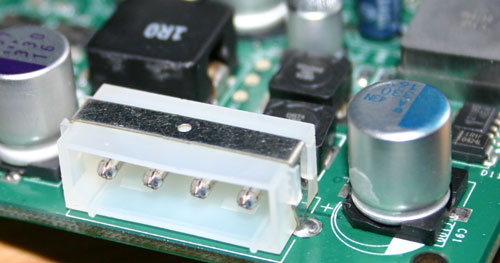
This 4-pin molex connector is only present on the AGP version of the 6600GT
As of now, NVIDIA is only releasing the 6600GT in an AGP flavor; the regular non-GT 6600 will remain PCI Express only. the 6600GT AGP will retail for between $200 and $250. If you are interested in learning more about the architecture of the 6600GT, feel free to read our review of the PCI Express version for greater detail.
The Cards
NVIDIA's reference board features dual DVI outputs and is brandished with some Doom 3 artwork on the heatsink:

XFX has a shipping 6600GT that they sent us:
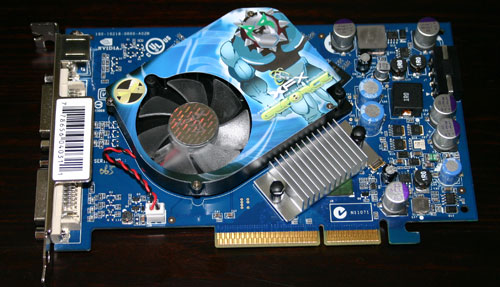
The XFX card is identical to NVIDIA's reference board except for one major factor - it is clocked at the PCI Express 6600GT speeds of 500/1000.
Head to Head: ATI Radeon 9800 Pro vs. NVIDIA GeForce 6600GT
Before we get to the full set of benchmarks we wanted to look at a couple of important direct comparisons to the 6600GT.
First we have ATI's Radeon 9800 Pro; using our RealTime Price Engine we see that the 128MB ATI Radeon 9800 Pro is currently selling for $214
Under Doom 3, the 6600GT performs at a minimum of 27% faster than the 9800 Pro at the lowest resolution we tested. Ramping up in resolution only widened the gap between the cards. The 6600GT remains playable all the way through our testing, while the 9800 Pro falls to less than half the 6600GT's frame rate at our highest resolution. Not only is this generation's midrange card outperforming a top of the line card from last year, but technologically and dollar for dollar this 6600GT is the very clear winner here as well.
|
Doom 3 Performance |
|||
|
|
ATI Radeon 9800 Pro |
NVIDIA GeForce 6600GT |
Performance Advantage |
|
640 x 480 |
82.9 |
105.9 |
27.7% |
|
800 x 600 |
63.9 |
100.3 |
57.0% |
|
1024 x 768 |
45.1 |
82 |
81.8% |
|
1280 x 1024 |
30.5 |
58.7 |
92.5% |
|
1600 x 1200 |
21 |
43.4 |
106.7% |
|
Winner |
- |
- |
6600GT |
The CS: Source VST also shows an increasing performance advantage with resolution. In two of the most demanding apps, the 6600GT is able to scale much better than its competition at this price point. These numbers are not as dramatic as the Doom 3 scores, but at the same time, NVIDIA cards have traditionally been stronger under OpenGL titles while ATI cards tend to hold there own when put to the DirectX test. Of course, this fact just amplifies the victory for the 6600GT.
|
Counterstrike: Source Visual Stress Test Performance |
|||
|
|
ATI Radeon 9800 Pro |
NVIDIA GeForce 6600GT |
Performance Advantage |
|
640 x 480 |
185.3 |
191.8 |
3.5% |
|
800 x 600 |
153.1 |
175.3 |
14.5% |
|
1024 x 768 |
103.3 |
133.3 |
29.0% |
|
1280 x 1024 |
65.8 |
83.3 |
26.6% |
|
1600 x 1200 |
51.2 |
68 |
32.8% |
|
Winner |
- |
- |
6600GT |
The two contenders traded blows in this DirectX 8.1 based game. The numbers are close across the board. The 6600GT leads at lower resolutions, while the 9800 Pro inks ahead above 1280. None of these numbers are hugely significant, and this game is a classic toss up. The engine is tried and true as it's based on the same technology used in UT2K3. It doesn't really push the hardware like other games we see on the list, but it is still a good test because many games licensed the Unreal Engine.
|
Unreal Tournament 2004 |
|||
|
|
ATI Radeon 9800 Pro |
NVIDIA GeForce 6600GT |
Performance Advantage |
|
640 x 480 |
69.9 |
72.3 |
3.4% |
|
800 x 600 |
69.3 |
71.4 |
3.0% |
|
1024 x 768 |
68.4 |
70.5 |
3.1% |
|
1280 x 1024 |
64.2 |
62.8 |
2.2% |
|
1600 x 1200 |
51.1 |
50.2 |
1.8% |
|
Winner |
- |
- |
Tie |
With the exception of UT2K4, Far Cry revives a trend: the 6600GT increases its lead in the benchmark as we increase the resolution. Far Cry didn't show as much favor toward the 6600GT as in Doom 3 or the Source VST, but the trend is still the same. While the 20% lead the 6600GT maintains at 1600x1200 is impressive, 37 fps may or may not be playable depending on how demanding of a gamer one may be. We like to see 40 to 45 fps in shooters at a minimum, but there is a subjective element to it, and we'll leave the final call to the reader.
|
Far Cry 1.3 Performance |
|||
|
|
ATI Radeon 9800 Pro |
NVIDIA GeForce 6600GT |
Performance Advantage |
|
640 x 480 |
88.8 |
86.3 |
2.8% |
|
800 x 600 |
77.7 |
80.8 |
4.0% |
|
1024 x 768 |
62.2 |
67.9 |
9.2% |
|
1280 x 1024 |
44.3 |
48.7 |
9.9% |
|
1600 x 1200 |
30.9 |
37.1 |
20.1% |
|
Winner |
- |
- |
6600GT |
Another DirectX 9.0 game shows that the 6600GT card has a resolution scaling advantage over the 9800 Pro that gives it much more bang for the buck. Halo's performance advantage numbers fall somewhere between Doom 3's and the Source VST's. Between the 9800 Pro and the 6600GT, current and future games will definitely see more benefit from the NVIDIA card.
|
Halo 1.05 Performance |
|||
|
|
ATI Radeon 9800 Pro |
NVIDIA GeForce 6600GT |
Performance Advantage |
|
640 x 480 |
119.4 |
131.7 |
10.3% |
|
800 x 600 |
88.9 |
111.7 |
25.6% |
|
1024 x 768 |
60.9 |
82.4 |
35.3% |
|
1280 x 1024 |
39.8 |
56.9 |
43.0% |
|
1600 x 1200 |
27.7 |
41.3 |
49.1% |
|
Winner |
- |
- |
6600GT |
In this older OpenGL title, we see the 9800 Pro scale better than the 6600GT, but the NVIDIA card still maintained a lead throughout the testing. Since the smallest advantage the 6600GT enjoyed was just under 3% at 1600x1200, this benchmark goes to in its favor. With OpenGL being NVIDIA's strong suit, and the 6600GT doing so well in al the other benchmarks, it is interesting that this would be the game in which the 9800 Pro would give some of its best competition. Of course, the fact that this game is based on a very fixed function type of engine could have something to do with that.
|
Wolfenstein: |
|||
|
|
ATI Radeon 9800 Pro |
NVIDIA GeForce 6600GT |
Performance Advantage |
|
640 x 480 |
101.4 |
107.6 |
6.1% |
|
800 x 600 |
100.8 |
107.5 |
6.6% |
|
1024 x 768 |
99.6 |
104.2 |
4.6% |
|
1280 x 1024 |
85.1 |
88 |
3.4% |
|
1600 x 1200 |
66.2 |
68 |
2.7% |
|
Winner |
- |
- |
6600GT |
ATI's 9800 Pro scales down better than the 6600GT here, but the NVIDIA card just outperforms the 9800 hands down.
|
Battlefield - |
|||
|
|
ATI Radeon 9800 Pro |
NVIDIA GeForce 6600GT |
Performance Advantage |
|
640 x 480 |
134 |
217 |
61.9% |
|
800 x 600 |
115 |
180 |
56.5% |
|
1024 x 768 |
93 |
134 |
44.1% |
|
1280 x 1024 |
73 |
97 |
32.9% |
|
1600 x 1200 |
53 |
68 |
28.3% |
|
Winner |
- |
- |
6600GT |
Once again, we see the 6600GT out performing and out scaling the 98000 Pro. This game isn't built for sheer frame rate, but, at the same time, the graphics can be intensive.
|
The Sims 2 Performance |
|||
|
|
ATI Radeon 9800 Pro |
NVIDIA GeForce 6600GT |
Performance Advantage |
|
800 x 600 |
48.7 |
50.3 |
3.3% |
|
1024 x 768 |
38.7 |
42.1 |
8.8% |
|
1280 x 1024 |
30.5 |
32.6 |
6.9% |
|
1600 x 1200 |
22.8 |
27.8 |
21.9% |
|
Winner |
- |
- |
6600GT |
Across the board, the 6600GT is a better buy than the 9800 Pro. There is no question that the performance is better across the board, and only gets better at higher resolutions. Add to that the fact that the feature set is a year newer, and there really isn't a debate.
Head to Head: NVIDIA GeForce 5900XT vs. NVIDIA GeForce 6600GT
If we take a look at the price of the GeForce FX 5900XT in our RealTime Pricing Engine, we see a card that hovers somewhere around $185. The 5900XT is the lower rung of the high end graphics cards from NVIDIA at the end of the year in 2003.
Under Doom 3, the 5900XT just can't keep up with the 6600GT, especially at higher resolutions. We are seeing the same type of pattern we saw with the 9800 Pro head to head: as resolution increases, so does the 6600GT's lead.
|
Doom 3 Performance |
|||
|
|
NVIDIA GeForce 5900XT |
NVIDIA GeForce 6600GT |
Performance Advantage |
|
640 x 480 |
65.6 |
105.9 |
61.4% |
|
800 x 600 |
50.2 |
100.3 |
99.8% |
|
1024 x 768 |
36.3 |
82 |
125.9% |
|
1280 x 1024 |
25.4 |
58.7 |
131.1% |
|
1600 x 1200 |
18.9 |
43.4 |
129.6% |
|
Winner |
|
- |
6600GT |
This test isn't even a contest. The 6600GT makes short work of the 5900XT under valve's VST test. Though, with Half-Life two finally released, we'll have to see just how good a predictor of performance the VST is.
|
Counterstrike: Source Visual Stress Test Performance |
|||
|
|
NVIDIA GeForce 5900XT |
NVIDIA GeForce 6600GT |
Performance Advantage |
|
640 x 480 |
81.8 |
191.8 |
134.5% |
|
800 x 600 |
60.6 |
175.3 |
189.3% |
|
1024 x 768 |
40.2 |
133.3 |
231.6% |
|
1280 x 1024 |
24.8 |
83.3 |
235.9% |
|
1600 x 1200 |
18.9 |
68 |
259.8% |
|
Winner |
|
- |
6800GT |
|
Unreal Tournament 2004 |
|||
|
|
NVIDIA GeForce 5900XT |
NVIDIA GeForce 6600GT |
Performance Advantage |
|
640 x 480 |
72.7 |
72.3 |
0.6% |
|
800 x 600 |
71.4 |
71.4 |
0.0% |
|
1024 x 768 |
67.2 |
70.5 |
4.9% |
|
1280 x 1024 |
51.9 |
62.8 |
21.0% |
|
1600 x 1200 |
39.1 |
50.2 |
28.4% |
|
Winner |
|
- |
6600GT |
The 5900XT is not playable at anything above 1024x768 in FarCry, but the 6600GT holds on and manages over a 100% performance advantage at the higher resolutions.
|
Far Cry 1.3 Performance |
|||
|
|
NVIDIA GeForce 5900XT |
NVIDIA GeForce 6600GT |
Performance Advantage |
|
640 x 480 |
60.2 |
86.3 |
43.4% |
|
800 x 600 |
45.7 |
80.8 |
76.8% |
|
1024 x 768 |
33.3 |
67.9 |
103.9% |
|
1280 x 10 24 |
23 |
48.7 |
111.7% |
|
1600 x 1200 |
16.4 |
37.1 |
126.2% |
|
Winner |
|
- |
6600GT |
Halo continues the 6600GT reign with almost double the performance across the board.
|
Halo 1.05 Performance |
|||
|
|
NVIDIA GeForce 5900XT |
NVIDIA GeForce 6600GT |
Performance Advantage |
|
640 x 480 |
71.4 |
131.7 |
84.5% |
|
800 x 600 |
55.1 |
111.7 |
102.7% |
|
1024 x 768 |
39.7 |
82.4 |
107.6% |
|
1280 x 1024 |
26.5 |
56.9 |
114.7% |
|
1600 x 1200 |
19.2 |
41.3 |
115.1% |
|
Winner |
|
- |
6600GT |
This OpenGL benchmark shows a tie between the two boards, and at lower resolutions the 5900XT board is acutally leading the 6600GT here. This older quake III engine based game definitely shows a side we haven't seen, but so far the 5900XT has tied one benchmark while the 6600GT has won all the rest. Let's contine on and see what the rest stack up like.
|
Wolfenstein: |
|||
|
|
NVIDIA GeForce 5900XT |
NVIDIA GeForce 6600GT |
Performance Advantage |
|
640 x 480 |
111.8 |
107.6 |
3.8% |
|
800 x 600 |
110.3 |
107.5 |
2.5% |
|
1024 x 768 |
103.7 |
104.2 |
0.5% |
|
1280 x 1024 |
84 |
88 |
4.8% |
|
1600 x 1200 |
64 |
68 |
6.3% |
|
Winner |
|
- |
Tie |
In Battlefield vietnam, the results are pretty steadily in favor of the 6600GT: it wins with over a 50% performance advantage every time.
|
Battlefield - |
|||
|
|
NVIDIA GeForce 5900XT |
NVIDIA GeForce 6600GT |
Performance Advantage |
|
640 x 480 |
139 |
217 |
56.1% |
|
800 x 600 |
106 |
180 |
69.8% |
|
1024 x 768 |
76 |
134 |
76.3% |
|
1280 x 1024 |
53 |
97 |
83.0% |
|
1600 x 1200 |
36 |
68 |
88.9% |
|
Winner |
|
- |
6600GT |
Running with 78% higher fps at 1600x1200, the 6600GT closes out its victory against the 5900XT.
|
The Sims 2 Performance |
|||
|
|
NVIDIA GeForce 5900XT |
NVIDIA GeForce 6600GT |
Performance Advantage |
|
800 x 600 |
33.4 |
50.3 |
50.6% |
|
1024 x 768 |
29 |
42.1 |
45.2% |
|
1280 x 1024 |
20.3 |
32.6 |
60.6% |
|
1600 x 1200 |
15.6 |
27.8 |
78.2% |
|
Winner |
|
- |
6600GT |
In every test but one the 6600GT dominated the 5900XT in performance and value. In our head to head battles, price was a key factor. Now that the 6600GT has entered the AGP market, there is no reason to look at either of these other two AGP based products.
The Test
AMD Athlon 64 FX-55
2 x 512MB OCZ PC3200 EL Dual Channel DIMMs 2-2-2-10
MSI K8N Neo2 nForce3 Motherboard
ATI Catalyst 4.11 Drivers
NVIDIA ForceWare 66.93 Drivers
Doom 3 Performance
Since even before its release Doom 3 has clearly been an NVIDIA selling point. It is built around OpenGL, and preliminary benchmarks showed NVIDIA hardware running Doom 3 faster than ATI a year before the game's release. The end product doesn't seem to have deviated from the initial track, and surely NVIDIA couldn't be happier. We see here that the 6600GT is outperforming ATI's 12 pipe x800 Pro part with the the 6800 GT setting the bar on performance very high.
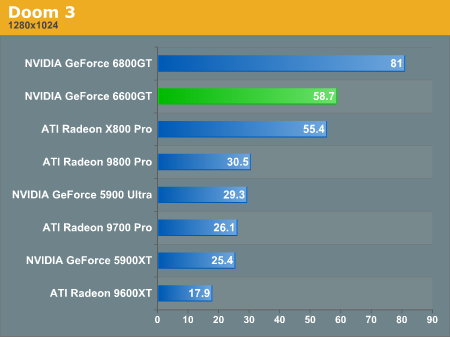
Under Doom 3 the 6600GT is a very powerful midrange card. Our resolution scaling graph shows a card with a profile that exceeds that of the x800 Pro. All of the previous generation cards fall a good distance behind the top three contenders in this test.
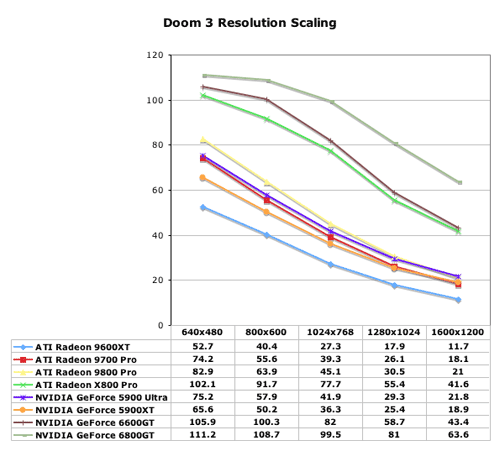
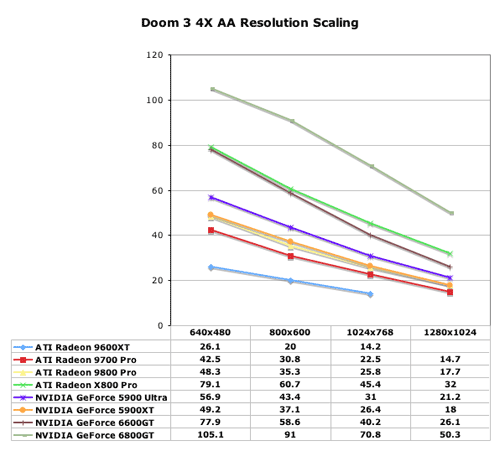
Counterstrike: Source Visual Stress Test
This time around, we look at a game where ATI has had a long time in the lime light. Valve has pushed Radeon cards as the way to go for Source engine based games, DirectX 9.0 based game engines have tended to favor ATI hardware at least as much as OpenGL has favored NVIDIA hardware. As such, the x800 Pro outperforms the 6600GT by a good ammount. The 9800 Pro is still lagging a good bit behind, which is a good sign for those who want an intermediate AGP upgrade and don't want to wait. People who have owned top of the line cards can get a performance improvement for midrange prices.
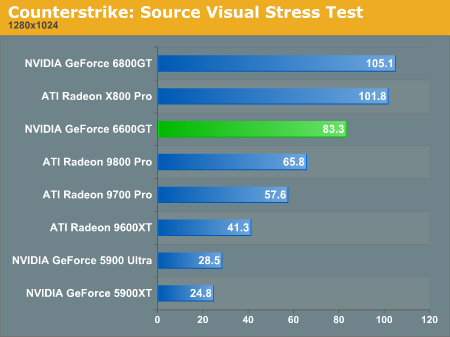
While the x800 Pro and 6800 GT scale about the same, the 6600GT does drop off a bit faster. The card does maintain a comfortable margine above the 9800 Pro though.
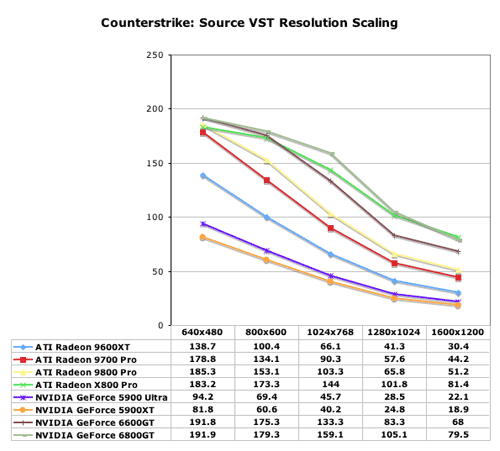
The older high end card can handle AA better than the 6600GT, and so scales a little better with resolution under 4xAA and the Source VST. At 1280x1024 the 9800 Pro very nearly catches up to the 6600GT.
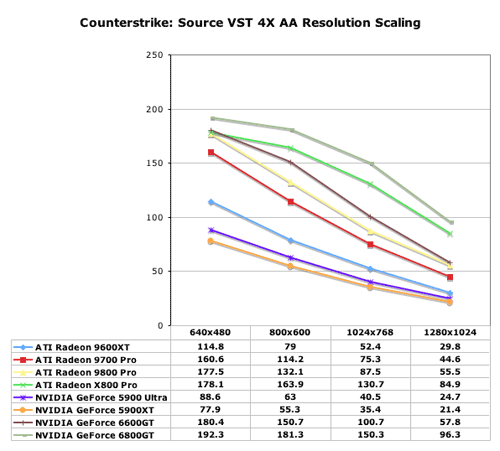
Unreal Tournament 2004 Performance
This test shows all the contenders very closer together. The 6600GT came out under the 9800 Pro here. There is less programmability explointed in this benchmark, as it is based on DirectX 8.1.
Resolution scaling in UT2K4 shows the cards bunched to gether until after 1024x768, and the 6600GT scales almost exactly with the 9800 Pro.
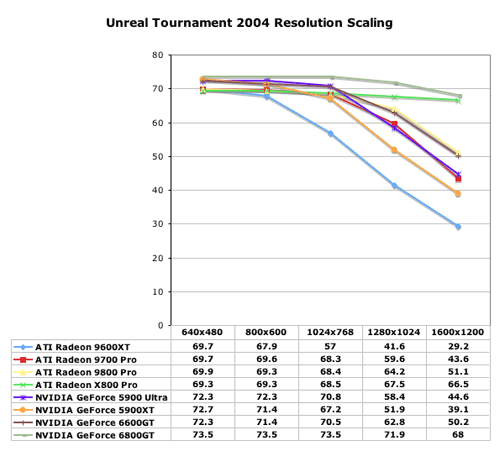
Again, when 4x AA is enabled, the midrange 6600GT isn't able to scale as well with some of the higher end cards of the previous generation. The 5900 Ultra and XT end up surpasing the 6600GT in these tests.

Far Cry 1.3 Performance
Once again we see the 6600GT fall between the x800 Pro and the 9800 Pro. The Far Cry benchmark has been touted by NVIDIA as one of the first PS 3.0 games, but it wasn't until the release of this patch that PS 3.0 features became available to the public. And oddly enough, things like geometry instancing are available on ATI hardware as well. CryTek and Ubisoft have done a good job of supporting both NVIDIA and ATI hardware and it comes across in the balanced benchmarks.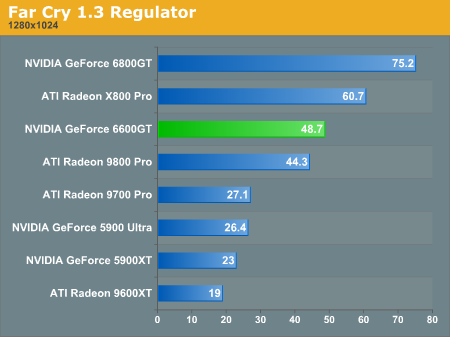
Our 6600GT scales fairly evenly between the 9800 Pro and x800 Pro under Far Cry. The resolution scaling is very spread out across the board here, but it's clear that current generation cards have an advantage.
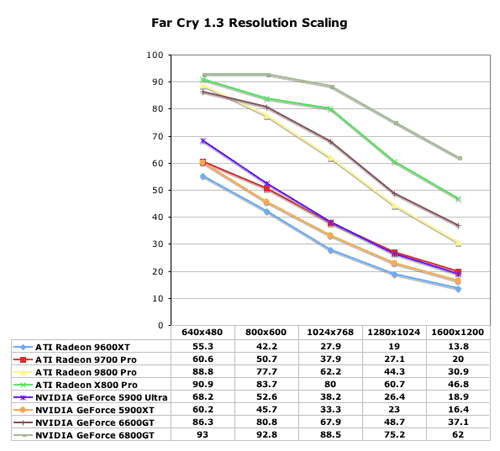
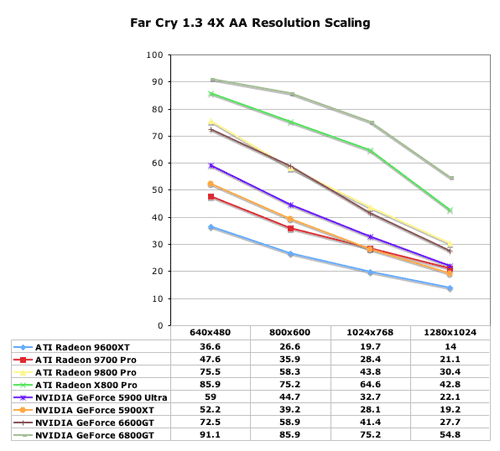
Halo Performance
One of the first DX9 games out there, Halo has also been one of the long favorites. This time closer to the x800 Pro than the 9800 Pro, the 6600GT puts in a very solid showing at 1280x1024. As usual, we are using the 1.05 version of Halo.
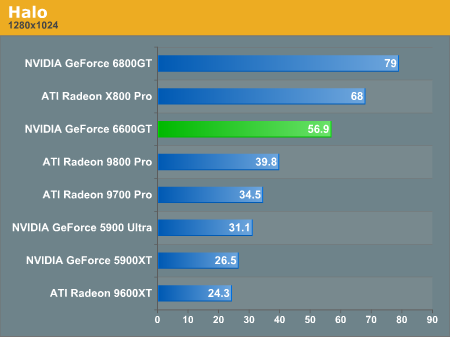
Resolution scaling shows the 6600GT to look like a droped down copy of the x800 Pro or the 6800GT. The 9800 Pro is performing more like the older bunch of cards in this test.

Wolfenstein: ET Performance
Wolfenstein ET offers the 6600GT a suprise visit from the 5900 Ultra. All the cards are packed in tight on this one, much like the Unreal Tournament test. Also like UT2K4, this test is less about programmability and more about fixed function processing, and the previous gen cards get another chance to shine.
The x800 Pro and 6800 GT aren't even stressed and could probably handle 2048x1536 just fine. The rest of the cards all started to drop at about the same rate after 1024x768.

This time, falling in under the 5900 Ultra and 5900XT, the 6600GT and 9800 Pro take a back seat to NVIDIA's previous generation high end cards in the 4x AA resolution scaling test. The x800 Pro and 6800GT of course lead the pack.

Battlefield: Vietnam
Here we see the 6600GT take its rightful place between the 9800 Pro and the x800 Pro at 1280x960. This time we're a little closer to the 9800 Pro, but the gap between the 9800 and x800 is quite large (the x800 hits about 2x the framerate of the 9800).
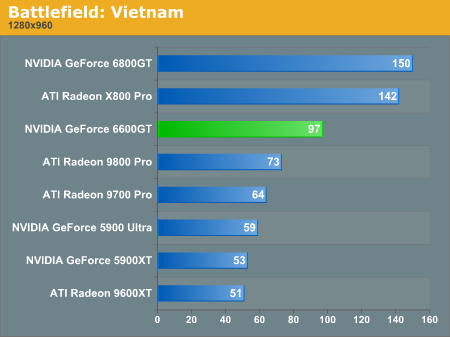
When we look at resolution scaling, it's hard to tell the 6800GT apart from the x800 Pro at first glance, and it's easy to see that the 6600GT splits the difference between the old gaurd and the high end.
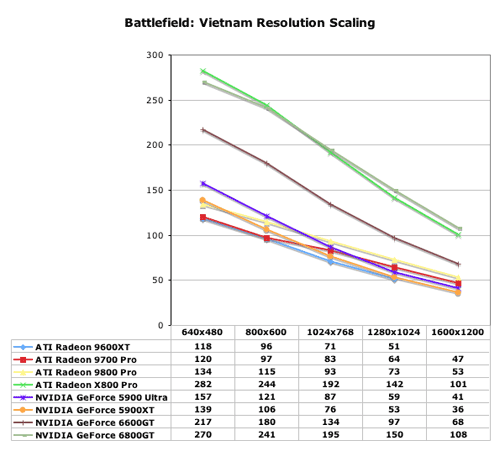
Of course, as soon as we flip on the 4x AA switch, the 6600GT falls in line with the 9800 Pro again.
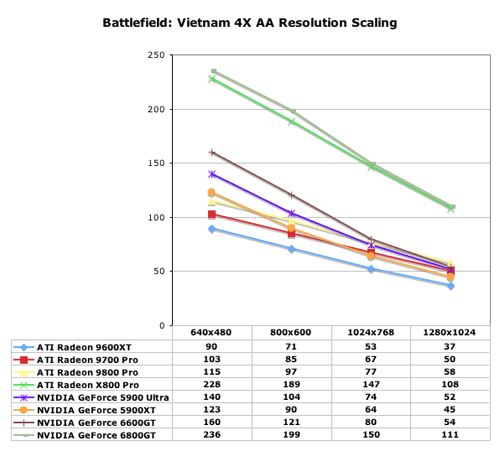
The Sims 2 Performance
In our final test, the 6600GT once again sits between the 9800 Pro and the x800 Pro. The relatively linear looking graph and low frame rates is due in no small part to the fact that The Sims 2 is not a heavily graphics centric game. The 3D interface and eye candy in this game is a means to an end, and not an end in and of itself. The popularity of this game, and the advantages of a smooth framerate therein afford it a spot in our benchmarking suite. And the 6600GT holds a nice position in this benchmark along with the rest of them.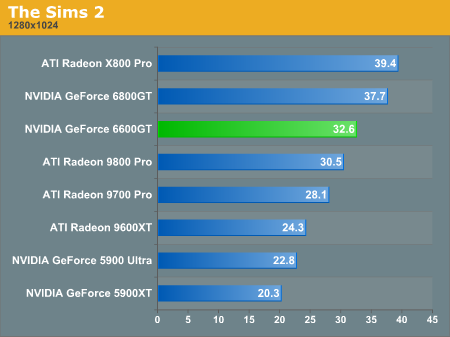
The x800 scales better (or is it worse?) with resolution than the other cards, but the 6600GT doesn't do a bad job either. At 1600x1200 the midrange NVIDIA card nearly catches up with its big brother the 6800GT. It seems to us that there is either an issue with the game or a driver that is causeing the x800 to be frame rate limited at lower resolutions, which is why we are seeing these strange numbers. Certainly the x800 posts the best numbers at the highest resolution, so it deserves recognition for that.
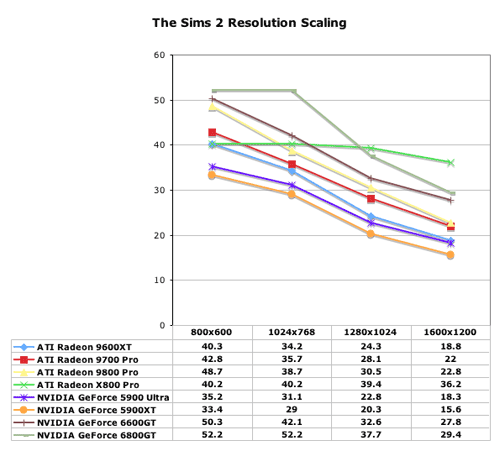
Final Words
NVIDIA's 6600GT was a strong performer when it was released as a PCI Express solution, but now as an AGP card it is even stronger for two reasons:
1) The market for a $200 - $250 AGP card is currently much larger than the market for a PCI Express version of such a card, and
2) ATI will be very late to market with their X700 XT AGP, thus giving the 6600GT AGP a unique window of opportunity for the remainder of 2004.
Compared to the $200 - $300 AGP cards available today, the GeForce 6600GT AGP can't be beat. While the Radeon 9800 Pro offers close performance in older games, switch to any of the latest titles and the 6600GT truly spreads its wings.
The performance improvement the 6600GT offers over NVIDIA's older $200 price point card, the 5900XT, is nothing short of amazing. The performance comparisons we showed here today are a testament to how much NVIDIA has improved their core architecture since the days of NV3x, with the 6600GT completely demolishing the 5900XT in performance. Even the $400 5900 Ultra is outperformed by the 6600GT in almost all of the benchmarks.
NVIDIA didn't do anything that ATI couldn't have done with the 6600GT AGP, however it was NVIDIA's PCI Express to AGP bridge that they tested and validated several months ago that gave NVIDIA the time to market advantage over ATI.
For the first time in recent history our GPU recommendation is clear: the best bang for your AGP buck is none other than the GeForce 6600GT.







